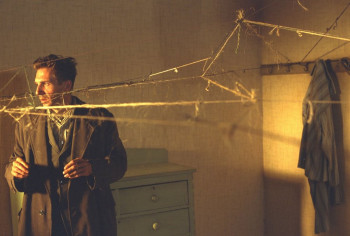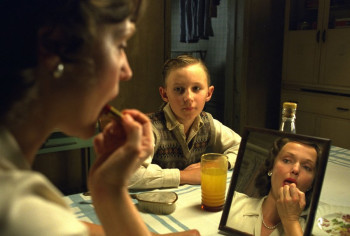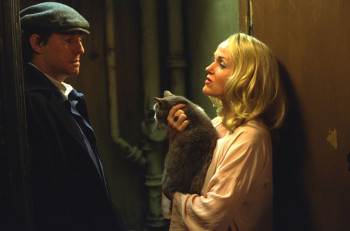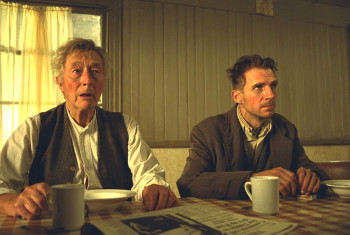Spider
 The release of David Cronenberg’s Spider on DVD was something I’d been looking forward to for months, because the movie never showed up in my medium-sized community (population 350,000) during its 54-theater run in 2003. Cronenberg is one of my favorite filmmakers, and Patrick McGrath’s novel (on which the movie is based) captivated me way back in college.
The release of David Cronenberg’s Spider on DVD was something I’d been looking forward to for months, because the movie never showed up in my medium-sized community (population 350,000) during its 54-theater run in 2003. Cronenberg is one of my favorite filmmakers, and Patrick McGrath’s novel (on which the movie is based) captivated me way back in college.
But after watching the movie, I was acutely underwhelmed and disappointed. It could be that the movie’s impact on my first viewing – akin to dropping a light object onto a feather pillow – was a function of overblown expectations. Or it could be that the movie was designed to end with more of a whimper than a bang. Or –
My fear is that I might be constructing some elaborate intellectual justification for a movie I didn’t actually like. It’s not that I’m a blind Cronenberg devotee – M. Butterfly and Crash just don’t work, and his movies before 1983’s The Dead Zone have difficulty escaping their small budgets. But Cronenberg seemed a natural match for the story of a schizophrenic man trying to piece together his past.
Spider feels slight from the opening credits forward, even though it involves mental illness, murder, sex, and Ralph Fiennes (in the lead role) with the most nicotine-stained fingers you’ll ever see. As a mystery or a thriller, it’s an utter failure – at least for those of us who knew the basic story.
 But a second viewing revealed a precise, measured elegance and intricate beauty to the narrative. Its Oedipal theme is obvious to a fault, but the movie is thorough in its exploration and ingenious in its literal treatment of both memory and psychosexual family dynamics. And the adaptation of the book is a wonder of transformation: McGrath (who wrote the script) and Cronenberg render the novel’s narrator nearly mute.
But a second viewing revealed a precise, measured elegance and intricate beauty to the narrative. Its Oedipal theme is obvious to a fault, but the movie is thorough in its exploration and ingenious in its literal treatment of both memory and psychosexual family dynamics. And the adaptation of the book is a wonder of transformation: McGrath (who wrote the script) and Cronenberg render the novel’s narrator nearly mute.
The movie concerns Dennis Cleg, a schizophrenic known as Spider who has just been released from a mental institution into a halfway house. It’s clear that Spider still isn’t quite right in the head. He keeps his valuables in a sock stuffed down his pants, mumbles to himself, and wears four shirts at all times. He intensely scribbles in his notebook in what’s either a private code or meticulously rendered nonsense, sometimes looking back a few pages to make sure he’s keeping the story straight. Spider is not merely writing down memories; he’s trying to figure something out.
 The halfway-house plot barely exists – there’s some business about missing keys and conflict with the landlady – and most of the movie visually re-creates Spider’s attempts to piece together what happened when his father’s attentions wandered from Mum to a pub tart (not to be confused with a Pop-Tart). Mousy Mum is upset by her husband’s straying eye and heavy drinking, and she tries to make herself attractive to him by buying a sexy slip. And it’s at this point that things take a turn for the worse for both her and Spider.
The halfway-house plot barely exists – there’s some business about missing keys and conflict with the landlady – and most of the movie visually re-creates Spider’s attempts to piece together what happened when his father’s attentions wandered from Mum to a pub tart (not to be confused with a Pop-Tart). Mousy Mum is upset by her husband’s straying eye and heavy drinking, and she tries to make herself attractive to him by buying a sexy slip. And it’s at this point that things take a turn for the worse for both her and Spider.
At the outset, Spider is subtly disorienting. The opening clearly sets the film in the present day, but as soon as Spider gets off the train, the past envelops him. Outside of the train-station scene and a remembered episode from the institution, Spider has a timeless quality; the action could be taking place at virtually any point in the 20th Century.
Identity, time, and place are liquid in Spider’s world, to wonderfully unsettling effect. The tart replaces the landlady at one point, and the use of Miranda Richardson in multiple roles gives the audience some sense of Spider’s confusion about the women in his life. And Spider has Dad issues as well, taking his father’s place in one sexual encounter.
As Spider travels through his memories, he is able, essentially, to view the action from any vantage point. Characters pass Spider on the street and enter the pub, and there sits Spider at a table, nursing a beer. Cronenberg doesn’t belabor this, and the technique is striking partly because of its casual presentation.
Spider is primarily an observer in his own re-constructed memories, physically standing in the background or in a corner and watching the past, including his younger self. But he’s also a participant. Sometimes Spider’s memories are leading him – for instance, he’ll repeat something that’s just been said – and sometimes he seems to be guiding them – putting words in people’s mouths. This suggests that he’s able to manipulate the past, in a way.
 Cronenberg’s and McGrath’s approach to the schizophrenic mind is interesting in its coherence and relative calm. Spider doesn’t inhabit the nightmare world we might imagine for schizophrenics (particularly those in a Cronenberg film). The movie thus suggests that although he has the outward tics of the mental illness, his time in an institution might have healed him to the point where he’s no longer crippled by his disease. (And McGrath would know about such matters, having grown up near the institution where his father worked as medical superintendent.) This leaves the viewer with a question: How much can Spider be trusted? For all the physical suggestion of schizophrenia, the mind seems lucid.
Cronenberg’s and McGrath’s approach to the schizophrenic mind is interesting in its coherence and relative calm. Spider doesn’t inhabit the nightmare world we might imagine for schizophrenics (particularly those in a Cronenberg film). The movie thus suggests that although he has the outward tics of the mental illness, his time in an institution might have healed him to the point where he’s no longer crippled by his disease. (And McGrath would know about such matters, having grown up near the institution where his father worked as medical superintendent.) This leaves the viewer with a question: How much can Spider be trusted? For all the physical suggestion of schizophrenia, the mind seems lucid.
These little details are the rich texture from which Spider derives its strength. There’s nothing here to blow you away, and I’m sure the movie will be as lost on most people as it was on me the first time. This is a restrained, finely calibrated, and highly polished tale that works on a small scale and reveals itself slowly. Ty Burr of the Boston Globe wrote the most evocatively accurate description:
“Cronenberg is working on a jeweler’s scale here: Imagine a hand-carved box that resists being pried open and whose contents are finally revealed to be both dangerous and terribly sad.”

